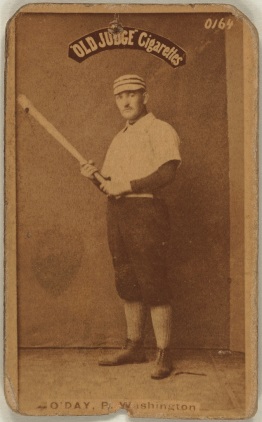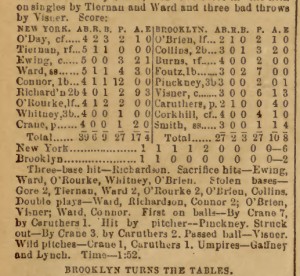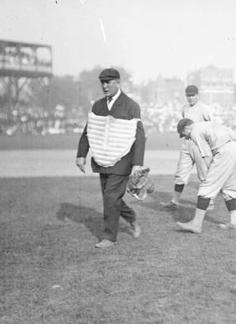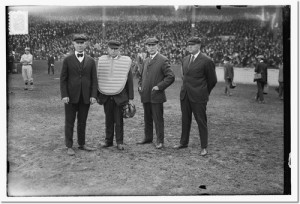Historical Hitter October 19th 1889: Hank O’Day

 Today the hitting hero is Giants Centerfielder Hank O’Day. Yet it also presents a great discrepancy that needs adjudication.
Today the hitting hero is Giants Centerfielder Hank O’Day. Yet it also presents a great discrepancy that needs adjudication.
On this day he led his team to a 6-2 victory over the then American Association Brooklyn Bridegrooms. A few years later when the National League absorbed the better American Association teams, the Bridegrooms will become the Dodgers. Thus, this game is the second game of the longest rivalry and definitely the fiercest in baseball, Giants-Dodgers. Sporting Life reported that the rivalry just a few games old was already taking shape as the rivalry it is today;
“The Giants Meeting With Antagonists Worthy of Their Steel—
The Brooklyns Holding Their End Up Well”
For the record, Sporting Life reported that the game:
“was played at Brooklyn Saturday, 0ct. 19, and won easily by New York, who outplayed their opponents’ at all points.”
Here is the great controversy: two baseball sources have O’Day with distinct hitting lines. The box score from the day is very different from the official record from Baseball-reference.com.
 According to the box score with O’Day going 3 for 4 with 2 runs scored. It was printed in Sporting Life, Volume 14, Number 3, October 30, 1889.
According to the box score with O’Day going 3 for 4 with 2 runs scored. It was printed in Sporting Life, Volume 14, Number 3, October 30, 1889.
Baseball-reference.com reports something different, for Hank O’Day is listed as having 6 at bats, and one hit, for the entire series. Click for the batting line from baseball-reference.com.
The 1890 Spalding Guide has O’Day with a different line: he batted .143 (which equates to 2 for 14, or 3 for 21) and played in three games. He won Game 6 (2-1, 11 innings) and the clincher game 8 (3-2, 9 innings). It’s nearly impossible for a pitcher to get 21 at bats in three games, with a total of 11 runs in 29 innings. See pages 116-118.
Baseball-reference.com has O’Day the pitcher during the World Series, giving a stellar performance, going 2-0 with a 1.17 ERA of and WHIP of 1.043, giving up 3 earned runs in 23 innings.
If any ready has more information to help to figure out the discrepancy, such information would be welcome.
1889 was a tumultuous year for baseball off the field. While AG Spalding and selected all stars were traveling around the World, back in the USA, a baseball revolt was brewing between the owners and players, then known as the Players Brotherhood. In one of baseball’s early labor disagreements, the sides dug in, and as a result the Players League was formed.
Also, the major issues confronting the game were player’s intoxication, critiqued by the Spalding Guide as on the field play being substandard and thus altering the game’s outcome. The Spalding’s Guide, and its editor Henry Chadwick, wrote that players needed to be and stay sober,
…his failure to do so, resulting from an unnatural appetite for intoxicating liquor, is as much a violation of his contract, as would be his conspiring to sell a game.
The batting issue of the day was the claim that players were going for the home run at the expense of team play. And that going for the home run was hurting the game.
… batsmen to get out of the rut of regarding heavy hitting as the sole criterion of skill in handling their bats. The mania for home run hitting which prevails in the ranks, is a drawback to skillful batting, and, in fact, it is opposed to the rule of team work in batting.
From within this setting of ownership/player issues and critiques of batting approaches Hank O’Day played. In 1889, he started the season with the defunct Washington Nationals and then on July 26, 1889 was purchased by the Giants. He was primarily a pitcher and then part time centerfielder, being a more successful pitcher than batter. The season was a season to two distinct parts: with the Nats he was 2-10 with an ERA of 4.33, and WHIP of 1.611; with the Giants he was 9-1 his ERA similar at 4.27 and WHIP 1.513.
He had only one winning season as a pitcher going 22 and13 with the Giants of the Players League in 1890, and led the National League in losses in 1888 with 23, and hit batsman with 16. And his career batting average was a Mendoza line dweller of .190 with a 35 OPS+.
Yet he was elected to the Hall of Fame in 2013. How could this be?
Hank O’Day was one of the few people who were a pitcher, outfielder, manager and Umpire. It was from his umpiring skill and stature that enshrined him at Cooperstown in 2013.
He was noted as being one of the best umpires in the game, and one of the most disagreeable people in baseball. He had no family, few friends, no outside interests; he was a baseball lifer.
He was a part-time umpire during his playing days, and became a full time ump in 1897. He was known as making the right call, no matter else. His most famous call was during the Merkle game at the Polo Grounds in which he called Merkle out and thus creating a tie game. What is particular about this call is O’Day was home plate ump that day so it’s questionable about what he saw, but his call was upheld by the National League President.
 Arguing with O’Day was a daunting task, if not one that players took with great trepidation. David W. Anderson quoted Christy Mathewson, who said arguing with O’Day was like,
Arguing with O’Day was a daunting task, if not one that players took with great trepidation. David W. Anderson quoted Christy Mathewson, who said arguing with O’Day was like,
“using a lit match to see how much gasoline was in a fuel tank.”
His integrity was above all reproach, and he was known to be one of the best umps having been chosen to ump 10 World Series, including the initial 1903 World Series.
Most curiously in the middle of his umpiring career he was hired in 1912 to manage the Reds, and again in 1914 to manage the Cubs. Neither team responded well to his leadership and both teams finished in 4th place, playing close to .500 baseball.

He then returned to the blue uniform until the 1927 season. From that day until his death he was a scout for umps. When he died in 1935, he was eulogized by National League President, John Heydler, who called him,
…one of the greatest umpires ever in terms of knowledge of the rules, fairness, and courage to make the right call.
But today Hank O’Day is a mystery at the plate. Did he go 3 for 4 or not? Who can make the right call?
[divider]
Sources:
http://baseballhall.org/hof/oday-hank
http://sabr.org/bioproj/person/94b47a84
http://www.baseball-reference.com/players/o/o’dayha01.shtml
Sporting Life, Volume 14, Number 3, October 30 1889
Chadwick, Henry, Ed. Spalding’s Base Ball Guide and Official League Book for 1890, AG Splading & Bros: Chicago & New York.
